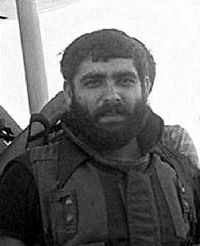February 15, 2008
Imad Mughniyeh: Hezbollah's Phantom Killed

By Ali Nourizadeh
London, Asharq Al-Awsat- Imad Mughniyeh, one of the world’s most wanted men, was killed in a car bomb in the Syrian capital, Damascus, late Tuesday night. Mughniyeh was on an FBI wanted list with a US$25 million bounty on his head equal to the bounty that the US has put for Al Qaeda leader Osama bin Laden.

Mughniyeh was implicated in a series of infamous attacks against US, Israeli and Jewish targets in Lebanon and abroad. On Wednesday, Hezbollah announced that Mughniyeh had been killed by Israeli agents.
The last time Imad Mughniyeh made headlines was in the summer of 2006, when rumors circulate about his role in directing Hezbollah's operations in southern Lebanon, an area whose geography he knew only too well, as a native of Tyre. He was also thought to have masterminded the kidnappings of the two Israeli soldiers, following a recommendation by the Iranian revolutionary guards.
Given the fact that only a few pictures of Mughniyeh ever exist, little benefit was gained by the FBI posting them on its website. Mughniyeh has undergone several plastic surgery operations throughout his life, which modified his facial features, most recently in 1997. According to US sources, Mughniyeh, use to spend his time traveling between Iran, Iraq, Lebanon and other countries, and has killed more American citizens than anyone else worldwide, at least prior to the September 11 attacks.
Wanted in 42 countries, Mughniyeh was an elusive man who shied away from the media, unlike Osama bin Laden, who has sought to exploit the media to publicize his aims. This is why Mughniyeh was known in extremist circles as “the shadowy man”, who doesn’t appear on television screens. Mughniyeh was also known as “the fox” in Iran, “Hajj Imad”, according to Hezbollah's secretary general, “the Shiaa bin Laden” in Israel and “The biggest murderer” in the United States.
Over the years, Mughniyeh had a few lucky escapes and survived numerous attempts on his life and foiled plans to kidnap him.
The Iranian public first heard of the surname “Mughniyeh” prior to the revolution in 1979, when a Lebanese Shiaa religious figure, Jawad Mughniyeh, published a best-selling book on the festival of Ashura and Imam al Hussein.
Several years later, after Khomeini came to power, a newspaper published the picture of Jawad with the caption “Father of the revolutionary Lebanese fighter Imad Mughniyeh”. Consequently, Imad Fayez Mughniyeh who bore no relation to Jawad became the prominent son of a religious family in eastern Lebanon. Years later, Iranians realized that Imad was not, in fact, the son of Jawad, but a Lebanese Shiaa young man who was inspired by the Iranian revolution and had established a cell responsible for hijacking planes in Beirut and kidnapping foreigners, as the civil war raged across Lebanon in the 1980s. He would later become the most elusive link between the Party of God and Iran.
Born in the southern Lebanese city of Tyre, in July 1962, to farmer parents, Mughniyeh grew up with two brothers, Jihad and Fouad, and later moved to the capital’s southern suburbs, where he attended school. He spent a year studying at the American University of Beirut.
Mughniyeh later joined “Force 17”, a special military unit that was tasked with protecting Fatah’s leadership in Lebanon (Yasser Arafat, Abu Jihad and Abu Iyad) and became a veteran sniper. After the Israeli invasion of Lebanon in 1982, Mughniyeh oversaw the transfer of weapons from Fatah and the PLO to the nascent Lebanese resistance, represented by Amal and Hezbollah.
Following the three-month siege of Beirut and the PLO’s departure from Lebanon to Tunisia, Mughniyeh joined the Amal movement and later Hezbollah, at the same time as the party’s current leader Hassan Nasrallah.
Anis Nacchache, a Lebanese who had led a failed assassination attempt on the former Iranian Prime Minister Shapour Bakhtiar in Paris, in 1980- after he announced his opposition to Ayatollah Khomeini’s regime- first introduced Mughniyeh to senior officials in the Iranian embassy in Beirut.
According to Abu Wafa, a former leader in the revolutionary guards, Mughniyeh stood out from other enthusiastic young men. On his first trip to Iran, in the early 1980s, Mughniyeh proved his military capabilities and excelled in his training. After three months of basic training, he traveled with other Lebanese Shiaa young men to the Iranian front and took part in several daring operations behind Iraqi lines, according to Iranian military leaders.
Imad then joined Hezbollah and was appointed by, Ahmad Motevaselian, a leader in the revolutionary guards in Beirut at the time, as the Party of God’s intelligence chief. His leading role in three operations made Mughniyeh’s name on the top of most-wanted lists in the United States and France: the bombing of the US embassy in the Lebanese capital in April 1983, in which 63 US and Lebanese individuals were killed, the bombing of the US Marines barracks in Beirut, in which 241 died and the bombing of the French barracks in the Bekaa Valley, which killed 58 French soldiers.
Mughniyeh was also tasked with protecting the life of Sheikh Hassan Fadlallah, the spiritual leader of Hezbollah, but with his exceptional abilities in field command and leadership, he became the head of the party’s special operations branch.
Mughniyeh disappeared from view for two years and re-emerged on board a kidnapped TWA flight in Beirut international airport in 1985, where he killed one of the passengers, a US Marine.
That same year, a car bomb exploded in front of Fadlallah’s house, killing 62, including Imad’s brother Jihad.
Mughniyeh also participated in the attempt to release a relative who was part of a group known as “Dawa 17” imprisoned in Kuwait after attacks on the US and Kuwaiti embassies. The men were released after the Iraqi invasion of Kuwait in 1990. He later kidnapped several westerners and released some of them, in the wake of secret negotiations with the Reagan administration.
According to an Iranian source, who met Mughniyeh on more than one occasion in Iran, the elusive figure had undergone plastic surgery to change his facial features in 1990. He then returned to Beirut incognito, under a new name and a false identity, with an Iranian diplomatic passport. Using several forged Lebanese, Syrian, Iranian and Pakistani passports, Mughniyeh successfully planned and executed a number of terrorist operations in Argentina in the mid 1990s, including the bombing of a Jewish center in Buenos Aires in 1994, killing 85.
During his constant traveling, Mughniyeh met Osama bin Laden and Ayman al Zawahiri in Sudan, where al Qaeda’s leader had established training centers in farms, while the revolutionary guards were also active in the country, under the guise of “Jihad for construction” organization, which was responsible for building roads and installations. When Mughniyeh’s cover was blown, he returned to Iran where he underwent a second operation and completely changed his look.
Between 1997 and the invasion of Iraq in 2003, Mughniyeh traveled between Iran, Afghanistan, Syria, Lebanon, Pakistan and northern Iraq, and assisted al Qaeda leaders to cross from Afghanistan to Iran. He then played a role in moving fighters loyal to bin Laden from Afghanistan to Iraq, through Iranian territory, by exploiting his relationships with the revolutionary guards, al Zawahiri, Saad bin Laden and Mohammed al Islambouli, whose brother assassinated the Egyptian President Anwar Sadat.
In 2005, he was tasked with organizing relations between the different Shiaa armed factions in southern Iraq. Mughniyeh then became the field supervisor of the revolutionary guard’s intelligence bureau in the region. That same year, he traveled to Lebanon through Syria, accompanied by Iranian officials, under the name of Sayyid Mehdi Hashemi, an Iranian national with a diplomatic passport.
In early 2006, reports indicated Mughniyeh had been seen in the city of Basra, where he is alleged to have been facilitating the entry of Mehdi army fighters into Iran, to take part in military training. In April, Mughniyeh was said to have returned to Lebanon where he held senior positions in Hezbollah's intelligence services and, according to Israeli sources, planned the operation to kidnap Israeli soldiers, based on orders from Iran’s revolutionary guards.
That same month, the Sunday Times newspaper reported that Mughniyeh took part in meeting between the Iranian president Mahmoud Ahmadinejad and his Syrian counterpart, according to security experts.
The man who according to Abu Wafa, was an opportunistic terrorist who did not know the meaning of humanity or sympathy was killed according to press reports as he was leaving his house and about to get into his car when it exploded. However, LBC, a Lebanese television station, said Mughniyeh was attending a ceremony at the Iranian school in Damascus and was killed as he left the function.
Israel has denied involvement.

